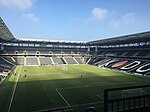Marshall Arena
2014 establishments in EnglandBasketball venues in EnglandBuildings and structures in Milton KeynesDarts venuesIndoor arenas in England ... and 4 more
London Lions (basketball)Snooker venuesSport in Milton KeynesSports venues completed in 2014

The Marshall Arena (formerly known as Arena MK, also Milton Keynes Arena) is a multi-purpose indoor arena in Milton Keynes, Buckinghamshire, England, located beside Stadium MK. The 3,420 square metres (36,800 sq ft) multi-use event space is positioned over three floors and anticipates music and sporting events, conferences, exhibitions and parties.
Excerpt from the Wikipedia article Marshall Arena (License: CC BY-SA 3.0, Authors, Images).Marshall Arena
V7 Saxon Street, Milton Keynes Denbigh North
Geographical coordinates (GPS) Address Website External links Nearby Places Show on map
Geographical coordinates (GPS)
| Latitude | Longitude |
|---|---|
| N 52.008333333333 ° | E -0.73277777777778 ° |
Address
Marshall Arena
V7 Saxon Street
MK1 1ET Milton Keynes, Denbigh North
England, United Kingdom
Open on Google Maps








